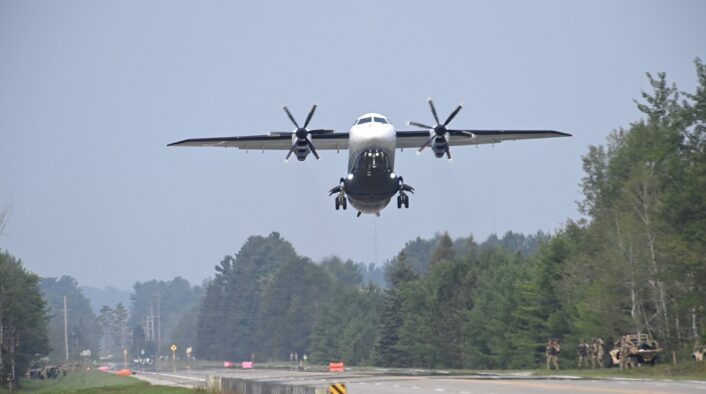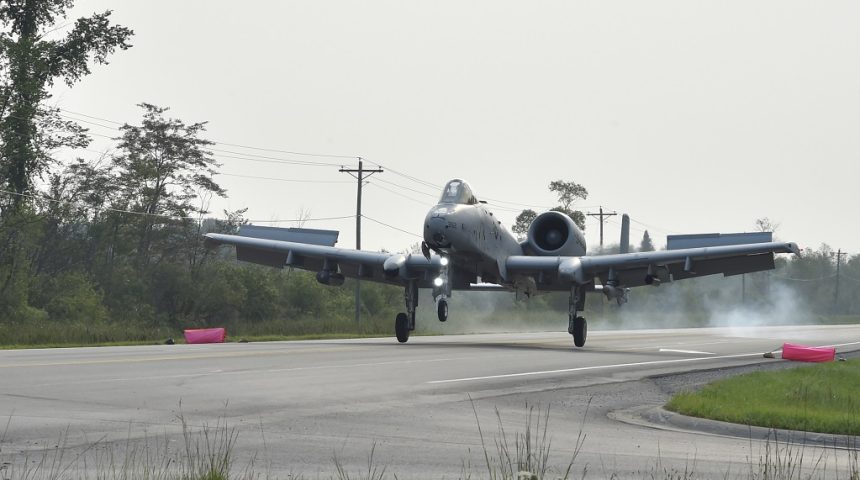This Agile Combat Employment event during exercise Northern Strike 21 represents the first time in history that the Air Force has purposely landed modern aircraft on a civilian roadway in the US.
The U.S. Air Force operated some of its aircraft from a state highway as part of the Agile Combat Employment concept during exercise Northern Strike 21. According to the press release, this was the first time in history that the Air Force has purposely landed modern aircraft on a civilian roadway in the United States, with four A-10 Thunderbolt IIs and two C-146A Wolfhounds landing on the Michigan State Highway M-32 near Alpena on August 5, 2021.
“Thunder LZ gave the pilots the opportunity to land in an austere environment that they’re not used to,” said Lt. Col. Brian Wyrzykowski, the mission commander for Thunder LZ and a KC-135 Stratotanker instructor-pilot at the 127th Wing. “But it’s also a first in the nation, as this is the first time that modern combat aircraft have landed on U.S. soil, on a highway.”
Multiple units took part in the “Thunder LZ” (Landing Zone) event, with the 354th Fighter Squadron (Davis-Monthan Air Force Base, Arizona) and the Michigan Air National Guard’s 127th Wing (Selfridge Air National Guard Base) deploying two A-10Cs each, AFSOC’s (Air Force Special Operations Command) 492nd and 919th Special Operations Wings deploying one C-146A each and the 24th Special Operations Wing deploying Special Tactics Airmen to establish the landing zone and provide air traffic control.
“Today’s training is directly applicable to what we would do during a deployed scenario in either combat or peacetime operations,” said U.S. Air Force Lt. Col. Jeff Falcone, the Special Tactics lead for the exercise. “We’re working on agile combat employment concepts, which basically makes the force more flexible, more maneuverable and creates challenges for our adversaries in different environments. It also increases the survivability of U.S. forces as we’re able to move around to more unpredictable locations to resupply, refuel or anything else we may need.”
To start the Thunder LZ training event, a team of Special Tactics Airmen, specialized in these operations, infiltrated, secured and controlled the airfield, which in this case was the closed M-32 highway. “The training event would not be possible without our Special Tactics Airmen,” said Lt. Col. Falcone. “Our Special Tactics are the critical team providing air ground communications including air traffic control, making sure the air assault zone is suitable for aircraft. Once the airfield was ready, the Special Tactics Airmen on the ground called in the first A-10C of 127th Wing to begin the landing operations.
The involvement of the Michigan ANG’s 127th Wing might not be casual, as the unit’s A-10s were the firsts to land on a highway in Estonia during Saber Strike 16, 32 years after the last highway exercise. While during the Cold War highway strips were used to get rid of the runway dependency in case of nuclear war, now they are used to operate everywhere from unpredictable locations and project combat airpower closer to the action quickly. Air Force senior leaders have emphasized that ACE will play a crucial role in tomorrow’s fight as the nation’s focus shifts to near-peer competition.
“This proof of concept proves that we can land on any highway and continue to operate,” said U.S. Air Force Capt. John Renner, 354th FS flight commander and one of the pilots who participated in the highway landing. “The A-10 allows us to land a lot more places to get fuel, weapons and other armament so we can operate anywhere, anytime. This will allow us to get away from using built-up bases that our adversaries can target by moving much more rapidly.”

Held as part of the Michigan National Guard’s annual, multinational, largescale military training event, Exercise Northern Strike, the landing took place within the national all-domain warfighting center, an area of airspace, ranges and bases geographically located in northern Michigan, where all-domain training occurs in a joint environment. Thunder LZ was established on a four-lane stretch of M-32 approximately three miles west of the Alpena Combat Readiness Training Center, giving participating units the chance to practice posturing forces in a combat scenario, practicing the forward-arming and refueling concept of ACE.
This is a small step toward increasing our confidence in operating from austere locations,” said Lt. Col. Gary Glojek, 354th FS commander. “We are increasing the number of areas we can operate from to generate and deliver attack airpower by operating from dirt and pavement runways. Accelerating change is all about seizing every opportunity to move forward to increase your readiness. We are ready to get within striking range, and we are ready to go generate and deliver attack airpower from thousands of locations across the world. We are going to continue to get lighter, faster, more maneuverable and more flexible as we do that.”
A C-146 @MINationalGuard aircraft takes off during testing on M-32 near #Alpena. pic.twitter.com/5TcdPwup52
— Michigan DOT (@MichiganDOT) August 5, 2021
The AFSOC C-146A played a key role in the training event, supporting the Special Tactics Airmen as they prepared to establish the highway landing zone. The C-146A Wolfhound is the military version of the Dornier 328 turboprop commuter airliner, modified to permit cargo and personnel transport missions and continuously deployed since 2011. The aircraft can carry a maximum of 27 passengers, 6,000 pounds of cargo, or up to four litter patients.
“The main mission of the C-146 is rapid responsive air mobility,” said the lead C-146 pilot for the exercise and aircraft commander assigned to the 492nd Special Operations Wing. “Our users are primarily special operations forces, but we can move other members around from the Department of Defense, other government agencies as well as host nationals. The type of aircraft we have in our mission set is ideal to work with the Special Tactics Airmen to make this effort come to fruition. Without our ability to infiltrate we wouldn’t be able to operate the A-10s from that austere location.”
Another A-10 @MINationalGuard aircraft takeoff during testing on M-32 near #Alpena. pic.twitter.com/133apQXDL9
— Michigan DOT (@MichiganDOT) August 5, 2021
With the successful landing of six aircraft from four different wings, the Thunder LZ event demonstrated the units’ ability to maintain interoperability as well as AFSOC’s commitment to serving as enablers to the total joint force. According to the press release, the event served as a proof of concept, demonstrating that “AFSOC, the Air Force and allies are not constrained to traditional runways and are ready to answer the call anytime, anywhere”.
“We really would not be doing any of this without AFSOC support,” added Lt. Col. Wyrzykowski. “This has been done overseas on roads that were made for aircraft, but this road was not made for aircraft. This really represents a new capability for the Department of Defense being able to operate off of a true highway.”









